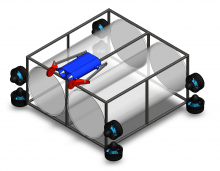UCI RoboSub
Background
The UCI RoboSub team represents the pilot program for a senior design project that hopes to become a competition team in the international Robosub competition. Our mission is to design, build, and program an innovative Autonomous Underwater Vehicle (AUV) capable of completing tasks in a challenging underwater environment. This hands-on project allows students to develop skills in systems engineering, software development, and teamwork while pushing the boundaries of underwater robotics.
Guided by our faculty sponsor, Dr. Sherif Hassaan, and supported by the MAE Department, the team collaborates across disciplines, including mechanical design, electrical engineering, and software development. Using cutting-edge technologies, we aim to eventually achieve success at a competitive level while contributing to advancements in underwater exploration and maritime industry applications.
Objectives
Our AUV will:
- Autonomy: Operate without human intervention, demonstrating advanced decision-making capabilities.
- Navigation: Accurately traverse underwater environments, utilizing sensors and algorithms to follow paths and avoid obstacles.
- Retrieval: Magnetically retrieve metal debris off of the seabed
- Sensing: Employ cameras, sonar, and other sensors to detect and interpret environmental cues essential for task completion.
- Communication: Maintain reliable data transmission for monitoring and potential inter-vehicle coordination.
Our project timeline encompasses research, design, prototyping, and rigorous testing phases. Through dedication, collaboration, and a shared passion for innovation, we strive to set new benchmarks in engineering excellence and foster a team culture of mutual respect and continuous learning.
Technical Details
The autonomous underwater vehicle (AUV) depicted utilizes a LiPo battery (<60VDC) as its energy source. It integrates ultrasonic sensors to gather environmental data for the purpose of differential control. The decision-making process occurs in the onboard computer, which processes input from sensors to generate navigation and task commands. These commands are relayed through a controller and Controller Area Network (CAN) to actuators such as thrusters, pneumatics, servos, and a kill switch. Fully autonomous functions include climbing/descending, omnidirectional movement, target debris location, sample collection, and obstacle avoidance.
Documentation
You can check out our team contract here to learn more about our team structure.
Sponsor
Dr. Sherif Hassaan | shassaan@uci.edu

